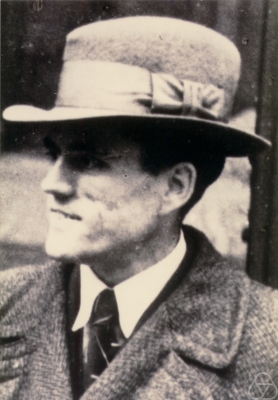Gerhard Gentzen facts for kids
Quick facts for kids
Gerhard Gentzen
|
|
|---|---|

Gerhard Gentzen in Prague, 1945.
|
|
| Born | November 24, 1909 |
| Died | August 4, 1945 (aged 35) |
| Cause of death | Starvation |
| Nationality | German |
| Alma mater | University of Göttingen |
| Scientific career | |
| Fields | Mathematics |
| Doctoral advisor | Paul Bernays |
Gerhard Karl Erich Gentzen (born November 24, 1909 – died August 4, 1945) was a German mathematician and logician. He made very important contributions to the basic ideas of mathematics. He also helped develop proof theory, which is about how mathematical proofs are built. He is especially known for his work on natural deduction and sequent calculus.
Gerhard Gentzen passed away in a prison camp in Prague in 1945. This happened after World War II ended. He was held there because he was a German citizen.
Life Story and Work
Gerhard Gentzen studied at the University of Göttingen. His main teacher was Paul Bernays. In 1933, Bernays was removed from his job. This was because the Nazi government considered him "non-Aryan." So, Hermann Weyl became Gentzen's official supervisor.
Gentzen joined a group called the Sturmabteilung in 1933. Even so, he stayed in touch with Bernays until World War II began. In 1935, he wrote letters to Abraham Fraenkel in Jerusalem. This led to trouble with the Nazi teachers' union. They accused him of keeping "contacts to the Chosen People."
In 1935 and 1936, Hermann Weyl tried to help Gentzen. Weyl wanted him to come to the Institute for Advanced Study in Princeton, USA. But Gentzen did not go.
From 1935 to 1939, Gentzen worked with David Hilbert in Göttingen. Hilbert was a very famous mathematician. Gentzen also joined the Nazi Party in 1937. In 1939, he took an oath of loyalty to Adolf Hitler for his university job. Starting in 1943, he taught at the German Charles University in Prague. He also worked on the V-2 rocket project for the SS.
Gentzen was arrested on May 5, 1945. This happened during an uprising in Prague against the German forces. He and other staff from the German University were then given to Soviet forces. Because of his past connections to Nazi groups, Gentzen was held in a prison camp. He died there on August 4, 1945.
Gentzen's Important Work
Gentzen's most important work was in the basic ideas of mathematics. He focused on proof theory. This field looks at how mathematical proofs are structured. He developed two key systems: natural deduction and the sequent calculus.
His "cut-elimination theorem" is a very important idea in proof theory. It helps us understand how proofs work. Some of his ideas also influenced how we think about the meaning of logical statements.
One of Gentzen's papers was published in a magazine called Deutsche Mathematik. This magazine was started by Ludwig Bieberbach. He supported "Aryan" mathematics, which was a Nazi idea.
In 1936, Gentzen proved that the Peano axioms were consistent. The Peano axioms are a set of rules for basic arithmetic. His proof showed that these rules do not lead to contradictions.
In 1939, he finished a major paper. In it, he studied the strength of Peano arithmetic. He showed that a certain principle, called transfinite induction, could not be proven within Peano arithmetic itself. This work helped to confirm Gödel's incompleteness theorems. These theorems show that there are limits to what can be proven in mathematics. Gentzen's proof was published in 1943. It marked the start of a new field called Ordinal analysis.
See also
 In Spanish: Gerhard Gentzen para niños
In Spanish: Gerhard Gentzen para niños

